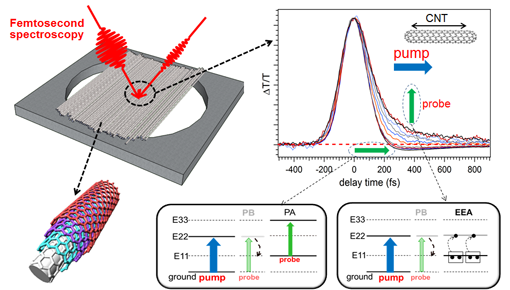ELPHOS
 Relaxation dynamics in carbon-based materials for photovoltaic applications
Relaxation dynamics in carbon-based materials for photovoltaic applications
Understanding the different steps of the exciton behavior such as formation, dissociation and charge transport in the fs timescale is mandatory to the development of high-efficiency solar cells
Surface and interface electron dynamics in graphene/metal and in surface-supported molecular nanostructures
Time-resolved angle-resolved non-linear photoemission is a powerfull tool to investigate electron dynamics at surface and at interface of carbon-based materials with metallic substrate.
Relaxation dynamics in carbon-based materials for photovoltaic applications
One of the key aspects underlying the application of novel materials in electro-optical devices is the understanding of the steps immediately following the hole-electron pair (exciton) photo-excitation: exciton transport, recombination and dissociation [12]. These processes occur on ultrafast timescales. Information on this timescale is difficult to access, and much of the current research into solar cell devices focuses on the time averaged properties. Such steady state measurements give little information about processes actually occurring on fast timescales. The goal of this research activity is to increase the performance of solar cell based on carbon nanotube (CNT) by understanding and optimizing the mechanisms, in the femtosecond domain, that enhance the solar light harvesting and the photon-to-electron conversion efficiency, by using time-resolved optical spectroscopies. Different architectures of CNT and CNT inorganic hybrids are the building blocks chosen for CNT-based efficient photovoltaic devices.

Surface and interface electron dynamics in graphene/metal and in surface-supported molecular nanostructures
Unlike conventional photoemission, that involves one-photon processes, non-linear photoemission is capable of investigating occupied as well as unoccupied states. Particularly relevant among the unoccupied states are the image potential states (IPS), that are expected to depend sensitively on the interaction between the carbon-based materials and the metallic substrate. These states, in fact, owing to its large spatial expansion into the vacuum and to the free-electron like character in the parallel plane, not only provide a very sensitive tool for the determination of the environment around the carbon sheet but plays a crucial role in the photoinduced charge transfer at the interface.
The main focus of this research activity is to track the relaxation dynamics, and in particular the photoinduced electron transfer mechanisms, on surface-supported carbon-based nanostructures where two key interfaces are involved, the lateral adsorbate-adsorbate interaction and the vertical adsorbate/substrate interface. The set of interfaces chosen for this study are graphene/metal interface and Donor-Acceptor systems deposited on metal.

